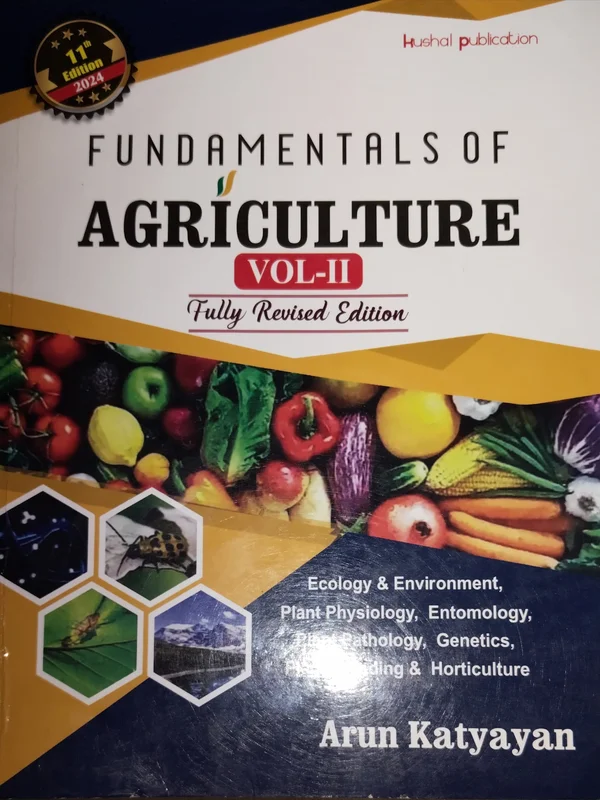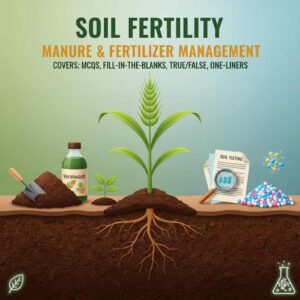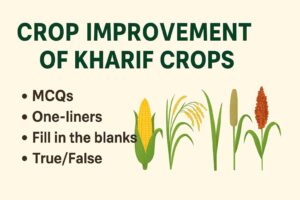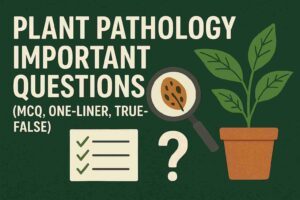fundamentals of agriculture arun katyayan Vol- 2
If you’re a BSc Agriculture student or preparing for exams like ICAR JRF, Pre-PG, or state-level agriculture entrance tests, then you’ve probably heard about Arun Katyayan’s agriculture books. After the popularity of Volume 1, his Fundamentals of Agriculture Volume-2 has become an essential book for students in their second and third years.
This book continues where Volume 1 left off and focuses on some of the most important subjects, like Genetics and Plant Breeding, Plant Pathology, Entomology, Horticulture, Crop Physiology, and more. The explanations are simple, clear, and written in a way that even average students can understand without needing extra coaching.
One of the best things about Arun Katyayan’s books is that they not only help you understand theory but also prepare you for competitive exams. Volume 2 includes important multiple-choice questions (MCQs), one-liners, and facts that are often asked in exams. That’s why thousands of students across India prefer this book during their exam time.
Arun Katyayan Volume 2 book pdf Download (Old Edition)

Arun Katyayan Volume 2 book pdf Download (New Edition)
Buy Arun Katyayan's agriculture book, vol. 2. book
Other important books-
Click to Join Our Free WhatsApp Group and YouTube for Agriculture Updates!
Get daily updates, free study material, and the latest schemes, and connect with other agriculture students and farmers.
Table Of Content
fundamentals of agriculture arun katyayan
1. Ecosystem:
Meaning, Abiotic & biotic components, Autotrophic Heterotrophic components, Types of Ecosystem, Energy Flow in Ecosystem, Ecological Pyramid; Pyramid of energy, number & biomass.
2,Biodiversity and its Conservation:
Meaning, Genetic, species & community diversity, Importance of biodiversity, Threat to biodiversity, Extinction of species, Red data book, Biodiversity in India, Endangered species in India, Indian Vultures, Hot spots, conservation of biodiversity, Wildlife sanctuary, National Park, Biosphere reserve and their differences, Important National Parks & Sanctuaries, Biosphere reserves in India, Ramsar site, Sacred Groves, Silent valley, Germplasm bank, Environmental laws, Indian forest Act.
3. Environmental Pollution :
Pollution and its type, Air pollution: Air pollutants, photochemical, Acid rain, ozone hole, particulate matters, aerosols, prevention and control of air pollution, Noise Pollution: decibel & Hertz, effects of noise pollution, source of noise, noise itensity and different source, control of noise pollution; water pollution: sewage other wastes, industrial effluents, Agl. discharges, thermal pollution, water pollution, Marine pollution, Mercury Pollution, control of water pollution; soil pollution, Sources, effects, control of soil pollution, Nuclear pollution: Sources, effects & control of nuclear pollution; Bioremediation, phytoremediation, categories of phytoremediation, some technical definitions relevant to bioremediation.
4. Disaster and Disaster management:
Natural Disaster: Earthquake, Landslide, Floods, Cyclones and their management; Tsunami, Manmade Disaster.
5. Water Relation:
Introduction, Diffusion, Osmosis, Osmotic Potential, Water Potential, Turgor Pressure, Chemical Potential, Osmotic Relations, Endoosmosis, Exo- osmosis, Role of Ostnosis, Factors affecting osmotic pressure, Imbibition, Plasmolysis, Absorption of water. Active absorption and their theories, Passive absorption, Factors affecting the rate of water absorption, Ascent of sap and different theories, Loss of water, Transpiration, Difference between transpiration and evaporation, Stomata and their types, Mechanism of stomatal opening and closing, Guttation, Bleeding, Difference between transpiration & guttation.
6. Photosynthesis:
Introduction, Photosynthetic Pigments, Photosynthesis, Light reactions, Robert Emerson’s work and red drop, Dark reactions, Calvin Cycle, Hatch and Slack Cycle, CAM; Photorespiratio.1, Factors affecting Photosynthesis.
7. Respiration:
Introduction, Types of respiration, Mechanism of respiration, Glycolysis, Anaerobic respiration, Aerobic respiration, Link, Krebs cycle, Difference between Calvin cycle and Kerbs Cycle, Phosphorylation, Electron transport system, Energy released during respiration, Efficiency of respiration, Respiratory Quotient, Difference between aerobic and anaerobic respiration, Difference between respiration and photorespiration, factors affecting respiration, Pasteur effect, Climacteric rise.
8. Enzymes:
Meaning, Types of enzymes, Mode of Action, Classification, Nature and properties, and Factors affecting Enzyme reaction.
9. Growth, Hormones and Growth Regulators:
Growth and Development, Phases of Growth, Factors affecting growth and development, Growth Harmones and regulators: Auxins, Gibberellins, Cytokinin, Abscisic acid (ABA), Ethylene, Difference between growth inhibitor and growth retardant.
10. Photoperiodism and Vernalisation :
Photoperiodism: Short-day plants, Long-day plants, Day-neutral plants, Critical Period, Photoperiodic induction, Flowering stimulus, Vernalization and devernalisation.
11. Agricultural Entomology: An Introduction:
Insect-Pest, Entomology, Phylum: Arthropoda, Insects: Ticks/Mites, Metamorphosis, Mouth Parts and its types, Damaging Stages, Bhopal Gas Tragedy:
12. Insecticides:
Mode of Action of Insecticides, Insecticides and their trade names, Inorganic Compounds, Organic Compounds, Synthetic Organic Compounds, DDT Analogs, BHC/HCH, Organo-phosphorus compounds, ‘S’- Containing Insecticides, Carbamate Insecticides, Synthetic Pyrethroids, Acaricides, Fumigants, Rodenticides, Generations of Insecticides, Insecticide Additives, Types of Formulation, Liquid Formulation/Spray, Gaseous Formulation, Calculations Regarding Formulation.
13. Plant Protection types of equipment:
Dusters, Introduction, Hand-operated duster or Hand Duster, Power (operated) dusters, Sprayer, Introduction, Types of Pump, Function of nozzle, Types of nozzle, Hand operated Sprayers, Hydraulic (Energy) Sprayers, Compression/Pneumatic/Air sprayers, Gaseous Energy/Air Blast Sprayer, Power Sprayers, Pneumatic/ compression/Air Energy Sprayer, Gaseous Energy Sprayer, Centrifugal Energy Sprayer, Other Equipments.
14. Integrated Pest management:
Introduction, Harmful Effects of Pesticides, Integrated Pest Management, Cultural Measures, Mechanical and Physical Measures, Biological control Measures, Successful examples of Biological agents used in Pest Management, Chemical Control, Pest Surveillance, Forecasting of pest attack, Introduction of pests from one country to other, Domestic Quarantine for Pests, Varietal Control, Male sterile Technique, Use of IGR, Pheromones, Attractants & Repellants.
15. Stored Grain Pests :
Rice Weevil, Khapra Beetle, Pulse beetle, Rice Moth, Lesser grain borer, Rust Red Flour beetle, Angoumois grain moth, Protection of Stored grain. Preventive Measures, Hygenic Measures, Physical Measures, Chemical Measures, Curative Measures, Aluminium Phosphide. (Celephos)
16. Insect Pests of Some Crops:
Insect pest of Paddy Crop, Rice gall Midge/Fly, Yellow stem borer, Plant Hopper, Insect pest management of Rice, Insect pests of Cotton, American bollwarm, Spotted bollwarm, IPM in Cotton, Measures for Bollwarms protection, Insect pest of Sugarcane, Sugarcane Leafhopper, Sugarcane root borer, Sugarcane shoot borer, Sugarcane top borer, Gurdaspur borer, IPM in sugarcane, Insect-Pest of Pulses, Pod borer, Gram cutworm, IPM in Puises, Insect pests of oil seeds, White grub, Mustard Aphid, Mustard sawfly, Painted bug, IPM in Oilseed, Insect Pests of Vegetables, Fruit fly, Red pumpkin beetle, Brinjal borer, Hadda beetle, Jassids (Leaf hoppers). Tomato fruit borer, Diamond-black moth, Mustard Aphid, Painted bug. Insect Pests of fruits and Fruit trees, Mango hopper, Fruit fly, Mealybug. Fruit-sucking moth, Citrus Psylla, Lemon butterfly, Anarbutterfly, San Jose Scale, Woolly aphid, Apple root borer.
17. Plant Pathology: An Introduction:
An Introduction: Technical terms An Introduction, Rust in India, Physiological Specialization.
18.Chemicals used in Disease Control:
Fungicides, Types of Fungicides, Thiocarbamate Fungicides, Metallic dithiocarbamates, Other Organic Fungicides, Antibiotics, Systemic Fun- gicides, Organo-mercurial Fungicides, Fungicides and their name.
19. Plant Disease Control:
Classification of Plant Disease Control Methods, General Principles of Plant Disease Control, Avoidance of the pathogen, Exclusion of Inoculum, Types of seed treatment, Eradication of the pathogen, Protective Measures, Development of Resistance in Hosts, Therapy of Diseased Plants, BACTERIAL DISEASES, MYCOPLASMAL DISEASES, VIRAL DISEASES, Diseases caused by Nematodes.
20. Disease-details Table:
21. Genetics: An Introduction:
Heredity, Variation, Phenocopy, Gene, Plasmid, Genome, Allele/ Allelomorph, Chromosome, History, spontaneous generations, Preformation, Theory of epigenesis, Theory of Inheritance of Acquired
characters, Theory of Pangenesis, Germplasm theory, the physical basis of heredity.
22. The Cell:
History, Cell parts, Prokaryotic and eukaryotic cells, plasmalemma, Cell wall, Protoplasm, Nucleus, Nucleolus, Chromosome, Mitochondria, Plastids, Endoplasmic Reticulum, Ribosomes, Golgibody, Lysosome, Tonoplast, Plasmadesmata, Centrosome, Genetic material, DNA & RNA, Genetic Code.
23. Cell Division:
Cell division cycle, Amitosis, Endomitosis, Brachymeiosis, Mitosis, Meiosis.
24. Mendel’s Laws:
Mendel’s life, Mendel’s Work, Reason for Mendel’s success, Mendel’s observations, Mendel’s Laws, Law of Segregation, Law of Independent Assortment, Deviations from Mendel’s law, Back cross & Test Cross,
25. Dominance & Gene Interaction:
Dominance, Penetrance, Expressivity, Pleiotropism, Lethality, Gene Interaction: Complementary genes, Epistasis, Inhibitory gene action, Duplicate genes, Polymeric gene action.
26. Linkage & Crossing Over:
Introduction, Strength of linkage, Linkage maps or genetic map.
27. Sex-linked, Sex influenced & Sex limited traits:
Introduction, Sex-linked traits, Non-disjunction of sex chromosomes, Sex-influenced traits, Sex-limited traits.
28. Cytoplasmic or Extranuclear Inheritance:
Introduction, Features of Cytoplasmic Inheritance, Practical application of cytoplasmic inheritance.
29. Modes of Reproduction & Pollination Control:
Apomixis and its types, Modes of reproducion parthenogenesis, Vybrid, Flower, Anthesis, Mechanisms promoting self-pollination, Classification of crop species on the basis of their natural mode of pollination, Mechanism promoting cross-pollination, Self-Incompatibility, Male Sterility, Chemical hybridising Agent.
30. Qualitative & Quantitative Characters:
Introduction, Qualitative Characters, Quantitative Characters, Pleiotropy, Penetrance & Expressivity, Gene Interaction. Polygenic inheritance, Phenotypic variance, Heritability.
31. Selection in Self-pollinated Crops:
Progeny test, Pureline theory, Pureline Selection, Mass-Selection, pedigree method, Bulk method, Backcross method.
32. Selection in Cross-pollinated Crops :
Hardy-Weinberg law, Inbreeding, Inbreeding Depression & Heterosis, Hybrid Vigour, its genetic basis, Hybridization, Metaxenia, Objectives of hybridization, types and procedure of hybridization, Emasculation and its techniques, Breeding method used in cross-pollinated: population improvement, Mass selection progeny selection, Recurrent selection, GCA, SCA, Hybrid & Synthetic Varieties, Synthetic/Composite Varieties, Germplasm Complexes, Multiline Varieties.
33. Breeding for Disease & Insect Resistance :
Pathogenicity, Development of diseases, Sources of disease or insect resistance, Methods of breeding.
34. Mutations in crops Improvement:
Meaning, types of mutation & its Characteristics, Mutagens, Mutation breeding, and y-garden.
35. Polypoidy:
Meaning, heteroploidy, Euploidy, Aneuploidy, Features of autopolypoids, Allopolypoids, Homoeologous chromosome, Amphidiploid, Synthesis of Triticale & Raphanobrassica, Evolution of Bread wheat, Amphidiploid Brassica sp., and Nicotiana tabacum.
36. Horticulture: An Introduction:
Meaning of Horticulture, Branches of Horticulture, Difference between fruits and vegetables. Daily requirement, Classification of Horticultural crops: Annuals, Biennials, Perennials, Temperate, subtropical, tropical; chilling requirements, classification of fruits: On the basis of natural growth, climatic requirement, cotyledons, ripening, climacteric fruits fruit morphology, Edible parts, Family; Botanical classification of vegetables, compound responsible for aroma, vegetable farming Kitchen gardening. Market gardening. Truk gardening. Vegetable forcing, gardening for vegetable processing, gardening for seed processing, floating gardening: Nutritive value of fruits and vegetables.
37. Pruning and Training:
Pruning: Types of Pruning: Top pruning: Heading back, Thinning out, Bulk pruning. Spur Pruning, Light Pruning, disbudding: Root Pruning, Ringing/Girdling. Top working, Arboriculture, Rockery: Training: Objective, Method of training: Central leader system, open centre, modified leader system; Espalier, Trophy, Topiary, Bonsai. silviculture, System of planting orchard: Square, Rectangular, Hexagonal Quincunx, contour system;
38. Plant Propagation:
Sexual propagation; main objectives, breaking of dormancy, components essential, methods, stratification, scarification, Acid scarification, Asexual propagation: Reasons for using vegetative propagation, disadvantage, Methods: by apomictic seedings, specialised structures, own root system cutting: advantages and disadvantages, Types of cutting: Root cutting, stem cutting: Herbaceous, soft wood, hardwood, Hard wood Leaf cutting: Layering: advantage and disadvantage, its types: simple layering, Tip layering, serpentine, mound, Trench, Air layering: Grafting: scion rootstock, Inter stock, Double grafting, Advantage and disadvantage, conditions for successful grafting, callus, Methods of grafting: spice, cleft, Bark, side, veneer, Whip, Approach or Inarching, Bridge, Top, saddle, Double and Epicotyl grafting; Budding: Scion bud, advantages, Methods: T-budding, Inverted T-budding, patch, Ring, Forkert, Modified forkert, chip budding.
39. Fruit Production :
General information, Mango, Guava, Papaya, Banana, citrus, Grape, Pineapple.
40. Vegetable Production :
Bhindi, Brinjal, Tomato, Chilli, Potato, Pea, cucurbits Carrot, Radish, Turnip, Cauliflower, Cabbage, Knol Khol, Onion, Garlic, Spinach, Amaranthus.
41. Post Harvest Handling and Processing:
Vegetables: Primary and secondary causes of losses, control of Post-harvest losses, Fresh Fruits, climacteric rise, storage life and optimum temperature for cold storage, calling Injury, Asepsis.
42. Fruit Preservation:
Appetizing, Pasteurisation, Blanching, Syruping or Brining, Jam, Jelly, Marmalade, Fruit juices: squash, cordial, sherbet, Puree, Nectar, Cocktail; candy, chemical preservatives: Potassium metabisulphite, Sodium benzoate.
43. Garden: Types and Parts:
Garden, Types of gardening: Formal, Informal, landscape gardening, Artistic gardening, Bio-aesthetic planning, English garden, Japanese garden, Persian garden, Mughal garden, Italian garden, Mughal gardens of Kashmir, Parts of Garden: Lawn, Hedges; classification of hedges, Edges, Shrubs and Shrubberies, Bodhitree, details of Annuals and Shrubs.
44. Details of Annuals & Shrubs :
45. Objective model Questions (With Answers):
Upcoming Agriculture Jobs 2025
BSc Agriculture all semester syllabus and notes
About the author
Arun Katyayan, born on 6th Dec. 1965 in a khatiya family at Kalapur, Patna. In 1983 he passed his tenth examination and in the same year he embraced the teaching of the Buddha. He obtained Master degree in Agriculture in 1993 from B.H.U., Varanasi. Here itself he studied Pali language and literatures.
Later on he went through Vipassana courses taught by S.N. Goenka ji and since then he is a regular Vipassana meditator. Anyone finds him always diligent in the Dhamma- work. Presently he works as an officer in the Legal Metrology,
fundamentals of agriculture arun katyayan PDF download ( Latest edition)
Conclusion-
If you’re preparing seriously for exams or just looking for a good resource to understand key topics better, Arun Katyayan Volume-2 is worth reading. Make sure to keep both Volume-1 and Volume-2 with you — they’ll be your best companions during your agriculture journey.
For more useful notes, PDFs, and exam updates, stay connected with our website AgriGramodaya.com. We’re committed to helping agriculture students like you succeed with free and reliable resources.
After Bsc agriculture jobs syllabus
Latest Syllabus | Download Here |
IBPS Agriculture Filed Officer | |
NABARD GRADE A | |
Food Corporation of India (FCI) | |
RAEO | |
RHEO | |
Food Inspector | |
IFFCO AGT | |
MP PAT | |
UPSSSC AGTA |
Read latest post-
ICAR JRF Agronomy: Decoding the 2024-2025 Papers & Cracking the IARI Code
ICAR JRF Agronomy 2 year paper analysis A high ICAR...
Read More100+ Manure, Fertilizer, and Soil Fertility Management MCQ with important one-liners, true/false & fill-in-the-blanks
Author–Kumesh choudhari Table of Contents Hey Agri-dost! Exam season is...
Read MoreBSc Agriculture Crop Improvement of Kharif Crops MCQ, one-liner, true/false & fill in the blanks questions for exams
Author–Kumesh choudhari For every agriculture student, understanding the BSc Agriculture...
Read MoreBSc Agriculture Plant Pathology MCQ, one-liner, true/false & fill in the blanks questions for exams
Author–Kumesh choudhari Preparing for BSc Agriculture Plant Pathology MCQ-based exams is never...
Read More



